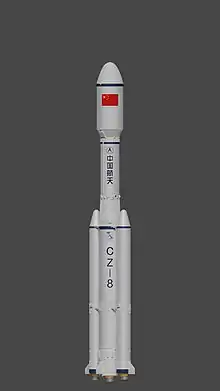 Rendering of Long March 8 Y1 | |
| Function | Orbital launch vehicle |
|---|---|
| Manufacturer | China Academy of Launch Vehicle Technology (CALT) |
| Country of origin | China |
| Size | |
| Height |
|
| Diameter | 3.35 m (11.0 ft) |
| Mass |
|
| Stages | 2 |
| Capacity | |
| Payload to SSO 700 km | |
| Mass |
|
| Payload to LEO | |
| Mass | 8,100 kg (17,900 lb) |
| Payload to GTO | |
| Mass | 2,800 kg (6,200 lb) |
| Associated rockets | |
| Comparable | Soyuz-2 Antares Falcon 9 (RTLS reusable) Ariane 6 H3 |
| Launch history | |
| Status | Active |
| Launch sites | Wenchang, LC-2 Jiuquan |
| Total launches | 2 |
| Success(es) | 2 |
| First flight | 22 December 2020 |
| Last flight | 27 February 2022 |
| Boosters (Standard) – K2 booster | |
| No. boosters | 2 or 0 |
| Height | 26.903 m (88.26 ft) |
| Diameter | 2.25 m (7 ft 5 in) |
| Powered by | 1 YF-100 |
| Maximum thrust | Sea level: 1,200 kN (270,000 lbf) Vacuum: 1,340 kN (300,000 lbf) |
| Total thrust | Sea level: 4,800 kN (1,100,000 lbf) Vacuum: 5,360 kN (1,200,000 lbf) |
| Specific impulse | Sea level: 300 s (2.9 km/s) Vacuum: 335 s (3.29 km/s) |
| Propellant | RP-1 / LOX |
| First stage – K3 core module | |
| Height | 25.083 m (82.29 ft) |
| Diameter | 3.35 m (11.0 ft) |
| Powered by | 2 YF-100 |
| Maximum thrust | Sea level: 2,400 kN (540,000 lbf) Vacuum: 2,680 kN (600,000 lbf) |
| Specific impulse | Sea level: 300 s (2.9 km/s) Vacuum: 335 s (3.29 km/s) |
| Propellant | RP-1 / LOX |
| Second stage | |
| Height | 12.375 m (40.60 ft) |
| Diameter | 3.0 m (9.8 ft) |
| Powered by | 2 YF-75 |
| Maximum thrust | 167.17 kN (37,580 lbf) |
| Specific impulse | 438 s (4.30 km/s) |
| Propellant | LH2 / LOX |
Long March 8 (Chinese: 长征八号运载火箭) is an orbital launch vehicle developed by the China Academy of Launch Vehicle Technology to launch up to 5000 kg to a 700 km altitude Sun-synchronous orbit (SSO).[2] The rocket is based on the Long March 7 with its first stage and two boosters, along with the existing liquid hydrogen burning third stage of the Long March 3A/3B/3C and 7A as its second stage. The boosters are omitted in the "core only" variant that first flew on its second launch in February 2022.[1]
A planned future launch vehicle variant of the Long March 8 will be partially reusable by featuring a combined booster recovery of the first stage and the boosters as a single unit.[3]
The maiden flight of the Long March 8 was launched on 22 December 2020 from the Wenchang Spacecraft Launch Site.[4]
Launch statistics
- Failure
- Partial failure
- Success
- Planned
List of launches
| Flight number | Date (UTC) |
Variant | Launch site | Payload | Orbit | Outcome |
|---|---|---|---|---|---|---|
| 1 | 22 December 2020 04:37[4][5] |
Standard | Wenchang, LC-2 | Xinjishu Yanzheng 7 (XJY-7) Haisi-1 Tianqi Xingzuo 08 (Ping'an-1) Yuanguang-1 ET-SMART-RSS (Zhixing-1A) |
SSO | Success |
| 2 | 27 February 2022 03:06[6] |
Core only[6] | Wenchang, LC-2 | Dayun (Xingshidai-17) Hainan-1 01, 02 Jilin-1 Gaofen-03D 10–18 Jilin-1 Mofang-02A 01 Qimingxing-1 Taijing-3 01 Taijing-4 01 Tianxian-1 (Chaohu-1) Chuangxing Leishen Wenchang-1 01, 02 XD-1 Tianqi-19 |
SSO | Success |
| 3 | March 2024 (TBD)[7] | Standard | Wenchang, LC-2 | Queqiao-2 Tiandu-1, 2 |
Selenocentric | Planned |
See also
References
- 1 2 3 4 "长征八号遥二运载火箭飞行试验取得圆满成功". people.cn (in Chinese (China)). 27 February 2022. Retrieved 18 March 2023.
- ↑ 贾平凡 (28 December 2020). "长征八号首飞成功 中国运载火箭家族再添新成员" (in Simplified Chinese). 新华社. Retrieved 27 February 2022.
- ↑ Jones, Andrew (30 April 2018). "China to test rocket reusability with planned Long March 8 launcher". SpaceNews. Retrieved 6 December 2020.
- 1 2 Jones, Andrew (22 December 2020). "China launches first Long March 8 from Wenchang spaceport". SpaceNews. Retrieved 22 December 2020.
- ↑ "长征八号运载火箭首次飞行试验取得圆满成功" [First Long March 8 rocket test flight was a complete success]. CNSA (in Chinese). 22 December 2020. Retrieved 22 December 2020.
- 1 2 Jones, Andrew (27 February 2022). "China launches national record 22 satellites on Long March 8 commercial rideshare". SpaceNews. Retrieved 1 March 2022.
- ↑ Seger Yu [@SegerYu] (2 October 2023). "The Queqiao-2 relay satellite is expected to be launched in March 2024" (Tweet) – via Twitter.